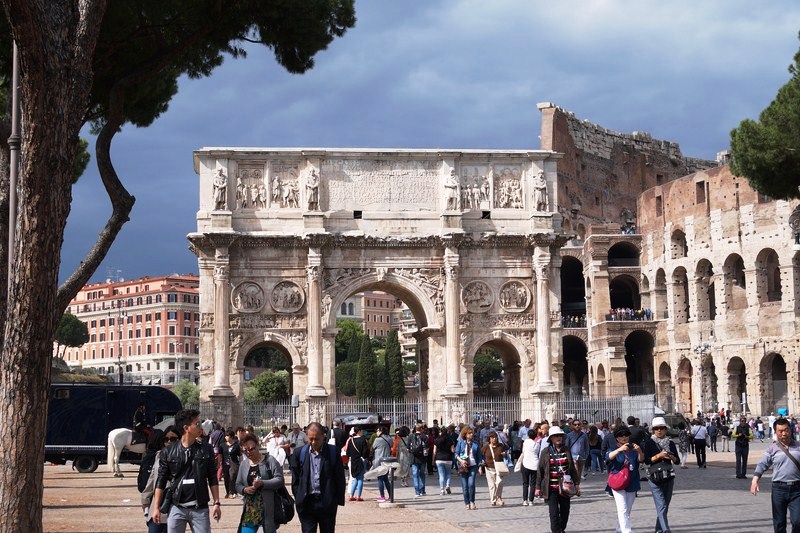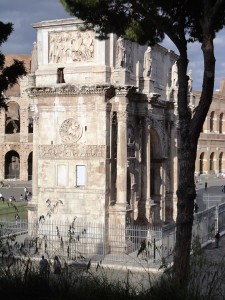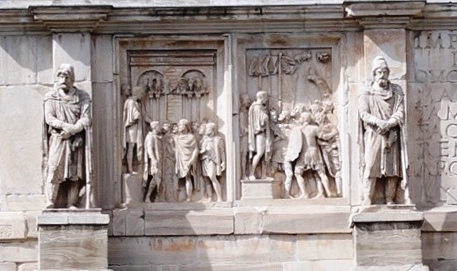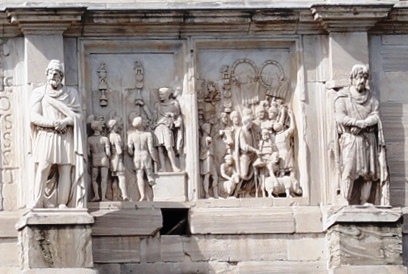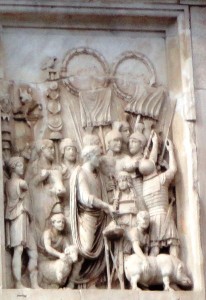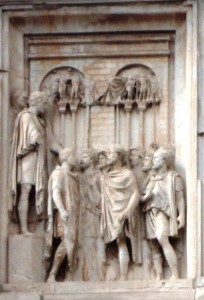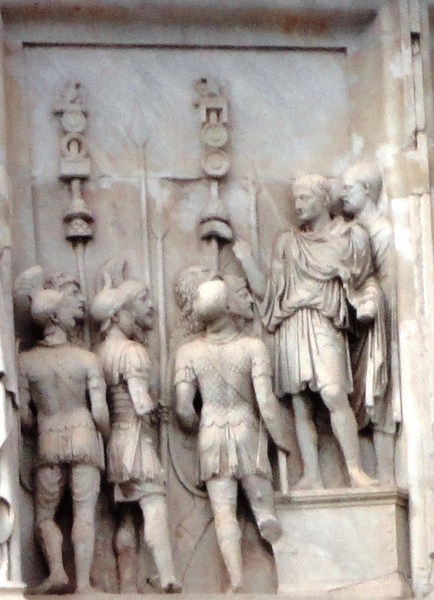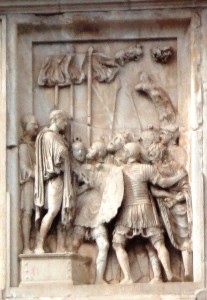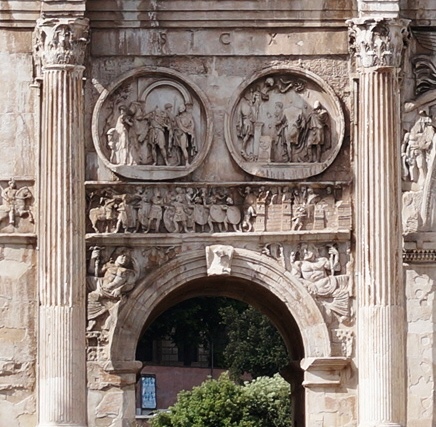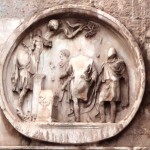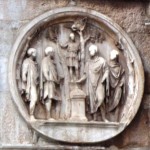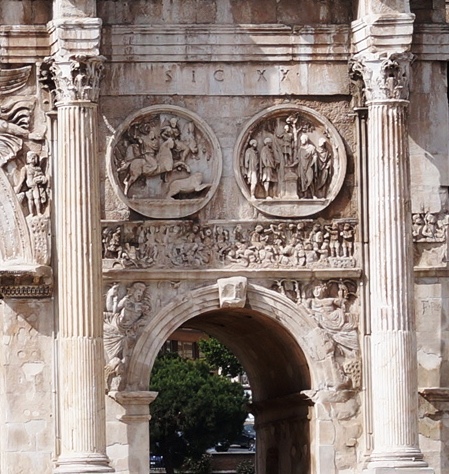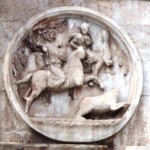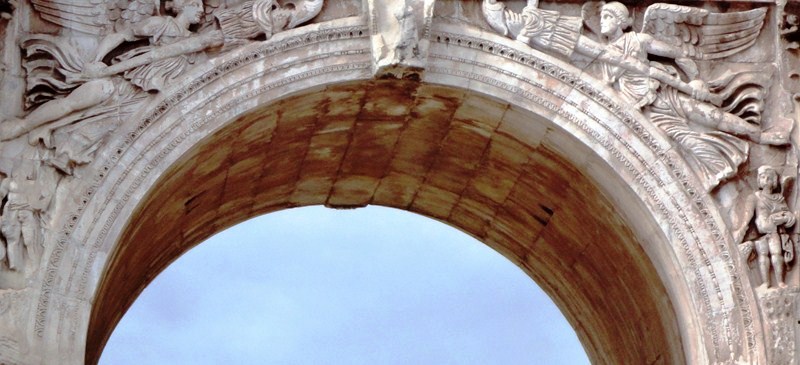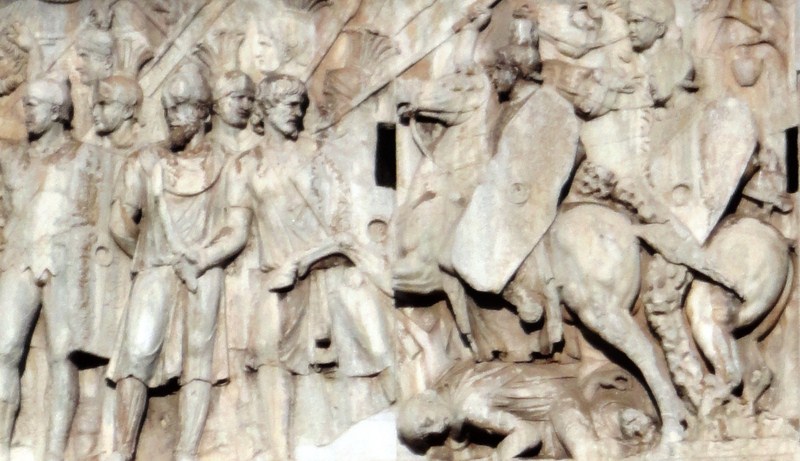Situated between the Colosseum and the Palatine Hill is the Arch of Constantine (Italian: Arco di Costantino), a triumphal arch erected and dedicated on July 25, 315 by the Roman Senate to commemorate, as described on its attic inscription, Constantine I‘s victory over the then reigning emperor Maxentius (306–312) at the Battle of Milvian Bridge on October 28, 312. The largest and the last of
the existing Roman triumphal arches, it spans the Via triumphalis, the way taken by the emperors when they entered the city in triumph.
Though dedicated to Constantine, this 21 m. high, 25.9 m. wide and 7.4 m. deep arch is actually a collage incorporating much of the decorative material from earlier work from the time of the emperors Trajan (98–117), Hadrian (117–138) and Marcus Aurelius (161–180).
It is also the only one to make extensive use of spolia, reusing several major reliefs from 2nd century imperial monuments to make up for the lack of time to create new art. The most impressive surviving civic monument from Rome in Late Antiquity, it is, with regards to its origins and meanings, also one of the most controversial.
The arch has three archways, the central one being 11.5 m. high and 6.5 m. wide and the lateral archways 7.4 m. by 3.4 m. each. The attic, above the archways, is composed of brickwork reveted (faced) with marble.
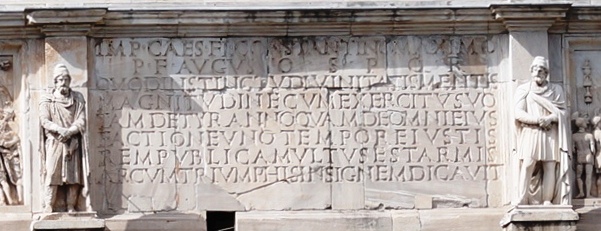
Inscription at the top of the attic – “To the Emperor Caesar Flavius Constantinus, the greatest, pious, and blessed Augustus: because he, inspired by the divine, and by the greatness of his mind, has delivered the state from the tyrant and all of his followers at the same time, with his army and just force of arms, the Senate and People of Rome have dedicated this arch, decorated with triumphs”
On the top of each column, large sculptures representing Dacians, dating from the time of Trajan, can be seen, which. Above the central archway, identical on both sides of the arch, is the inscription, forming the most prominent portion of the attic.
Above the minor lateral archways, flanking the inscription on both sides, are four pairs of relief panels (eight in total), taken from an unknown monument.
It commemorates Marcus Aurelius’ war against the Marcomanni and the Sarmatians from 169 – 175, which ended with Marcus Aurelius’ triumphant return in 176. They are, from left to right:
- the emperor’s return to Rome after the campaign (adventus) – north side
- the emperor leaving the city and saluted by a personification of theVia Flaminia – north side
- the emperor distributing money among the people (largitio) – north side
- the emperor interrogating a German prisoner – north side
- a captured enemy chieftain led before the emperor – south side
- other prisoners led before the emperor – south side
- the emperor speaking to the troops (adlocutio) – south side
- the emperor sacrificing a pig, sheep and bull (suovetaurilia) – south side
From the same time period the two large (3 m high) panels decorating the attic on the east and west sides of the arch show scenes from Trajan‘s Dacian Wars.
Together with the two reliefs on the inside of the central archway, these came from a large frieze celebrating the Dacian victory.
The general layout of the main facade is identical on both sides of the arch. The four columns (one of which has been transferred into the Basilica di San Giovanni in Laterano and was replaced by a white marble column), on bases (plinths or socles), are of the Corinthian order, decorated on three sides and made of Numidian yellow marble (giallo antico).
They divide the structure into a central arch and two lateral arches, the latter being surmounted by two round reliefs, dating to the times of Emperor Hadrian, over horizontal friezes.
The reliefs on the front show Victoria, either inscribing a shield or holding palm branches. Those to the side show captured barbarians alone or with Roman soldiers.
The pairs of round reliefs display scenes of hunting and sacrificing:
- hunt of a boar – north side
- sacrifice toApollo – north side
- hunt of a lion– north side
- sacrifice toHercules – north side
- the departure for the hunt – south side
- sacrifice toSilvanus – south side
- the hunt of a bear – south side
- sacrifice toDiana – south side
In all the medallions, the head of the emperor, originally Hadrian’s, has been reworked. On the north side, it has been reworked into Constantine in the hunting scenes and into Licinius or Constantius I in the sacrifice scenes. On the south side, it’s vice versa. The porphyry framing of the 2 m. diameter reliefs is only extant on the right side of the northern facade. Similar medallions, also during Constantine’s time, are located on the small sides of the arch. The Sun and the Moon, both on chariots, rises on the eastern and western sides, respectively.
The spandrel of the main arch is decorated with reliefs depicting victory figures with trophies while those of the lateral arches show river gods. The bases of the columns and the spandrel reliefs are from the time of Constantine. The “historical,” horizontal frieze below the round reliefs depict scenes from the Italian campaign of Constantine against Maxentius (which was the reason for the construction of the monument), one strip above each lateral archway and including the west and east sides of the arch. Running around the monument, they are the main parts from the time of Constantine.
The frieze starts at the western side with the Departure from Milan (Profectio), continues on the southern face, with the Siege of Verona (Obsidio) on the left (southwest), an event which was of great importance to the war in Northern Italy. The Battle of Milvian Bridge (Proelium), with Constantine’s army victorious and the enemy drowning in the Tiber River , is depicted on the right (southeast).
Constantine and his army enter Rome (Ingressus) is depicted on the eastern side while on the northern face, looking towards the city, are two strips with the emperor’s actions after taking possession of Rome. On the left (northeast) is Constantine speaking to the citizens on the Forum Romanum (Oratio) while the final panel, to the right (northwest), depicts Constantine distributing money to the people (Liberalitas).
On each wall of the central archway is one large panel of Trajan’s Dacian War. Eight portraits busts (two on each wall) inside the lateral archways are destroyed, to such an extent that it is no longer possible to identify them.
Arch of Constantine : Via di San Gregorio, Rome, Italy.

